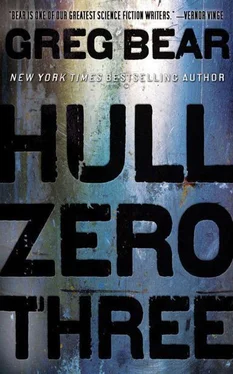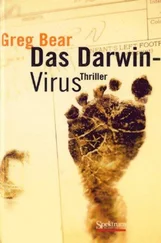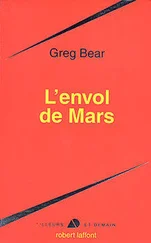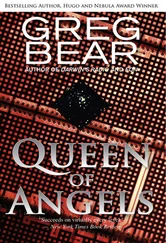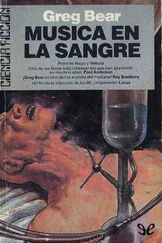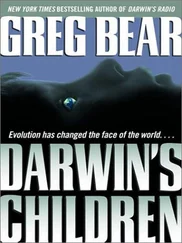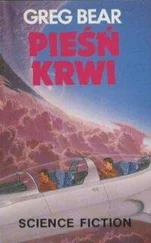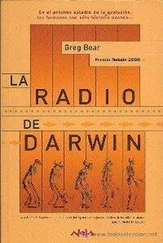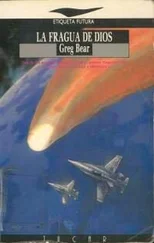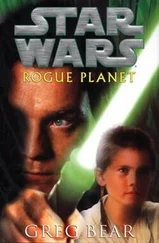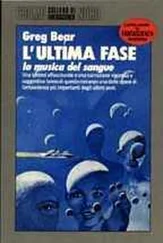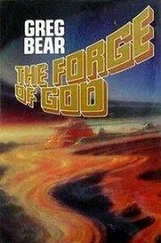The grinding and vibration settle long enough for us to make our way through the hatch, across the staging area, and along the bars and cables, back to the forward chamber. Here, we’re almost floating, the spin has been so reduced. We’re used to that. We’re used to having things go wrong. We seem hardly rattled at all, and the way we move, the way we help each other—I even grab Tsinoy’s paw to pull it through a tight hatch—means we’re finally acting as a team.
Tomchin is right beside us as we tug and haul ourselves up to the bow chamber, where nascent outlines—squares and rectangles and ovals—still glow gently. Where pylons and controls will pop up, we hope, if only we ask.
“Tell it!” Nell shouts at the two of us, looping her foot around a cable and stretching to her full, impressive two and a half meters.
“Show us the stars, build us controls—” my twin says.
Before he can finish, the hull is already fulfilling our request. More teardrops rise, then shape into horizontal control boards, thickening, spreading wide, and all the while, the panels covering the bow viewports slide up and away. Once more, we stare out at the universe—at wisps and the endless diamond-dust glow of uncounted millions of stars.
But something’s missing.
Tsinoy lets out a whimpering groan, far beneath his dignity, and I slowly catch on, then share his concern. It’s all about what we don’t see. The grayish misty lines and the forward umbrella shield are no longer visible.
“The deflection cone,” Tsinoy says. “It’s gone .”
“Great,” Nell says.
“What’s that mean?” Kim asks.
“We’re moving very fast,” Tsinoy says, and shivers uncontrollably. Its teeth snap—it can hardly control its rage and disappointment. “The interstellar medium—grains of dust, gas… on the edge of the nebula…”
“We’re naked, right in the middle of a big storm,” Nell says. She moves over to the far edge of the viewports and tries to look down and back. She doesn’t have to look far. “The hulls are exposed, but that bump down there on the little moon, it’s still got something around it—the moon is protected, too. They’ve got a shield.”
“It’s Destination Guidance. They’re trying to scrape us off,” Kim says.
Nell has moved back to the board mounted farthest forward. It, too, has a small blue dome mounted in the center, and little else. She places her hands on the dome, and dim lights flicker around her face and arms. My twin and I join her, with Tomchin coming up right beside us, a new expression on his generally stoic face.
“What’s he know?” Kim asks from behind us. Nell breaks contact long enough to look, then urges us to put our hands on the dome, as before.
“All together,” she says.
We connect to the hull, becoming receptive points in a vast space full of information. The abstraction seems familiar, exactly what we expect—but there are far too many ugly patches of what looks like char, burned darkness, signifying blank spots in the hull’s memory. At a rough guess, it looks as if more than ninety percent of the space is damaged, inaccessible—or simply gone.
Tomchin is here with us. He’s controlling a part of the display, searching, leaving the rest of us to explore in our own regions of, what, expertise? Instinct? Programming?
“I hate this,” my twin says. I hear him through my ears but see flashes of his presence in the void—an angry, searching presence, matching my moves closely, but not exactly. “We need ten of us up here!”
“Only if the knowledge still exists to spread among you,” Tomchin says. It’s his voice, but in the space, we hear it in our language—and we understand it. His patch of awareness is off in a far corner of the area. He seems to be rummaging , searching for landmarks.
Then his presence rejoins us, and he’s hauling a tendril of connectivity, like a brilliantly jeweled cable—signifying a distant branch of hull memory. “It’s broken,” Tomchin says. “But this used to lead directly to the gene pool, to Life Design.”
Yes! Those words, those names…
“Can you follow it?” Nell asks him.
Without answering, he’s off again—physically still close, but his presence impossibly far away in an instant.
The Tracker is also with us now, apparently accessing through another board. “This hull still keeps a large share of Ship’s memory,” it says, and for the first time, I realize that Tsinoy is female —her presence is rich with identity. The Ship, the hull, knows her, trusts her, needs her. She’s an astrogation specialist. She may be the most important person among us—and because of her design, the one most likely to survive. Things begin to make a stark sort of sense. Maybe it’s the rest of us who are expendable.
Tsinoy pulls up a dense starfield, then demos how each star has a descriptor, rendered in a number of shifting symbol sets and languages. “The information has been updated continually,” she says.
“All Ship’s children got clues,” Nell says. “Let’s hope they’re enough to get us somewhere.”
The rumbling and grinding outside of our connected experience is low-key, not very distracting. We assume Kim will warn us if anything worse happens. In here, we’re exploring . Our need is painfully acute, more crucial than quenching thirst or assuaging hunger.
We might be about to find out why we are.
Tsinoy is trying to figure out where we are headed. The first thing she discovers is that Ship is 439 light-years from Earth’s sun. There’s another measure of our distance traveled, more absolute—something to do with the crests of hyper-length cosmological gravitational waves, but it’s a bigger number, surrounded by dense mathematics, so we stick with light-years, because the memory of a year is so rich with other associations.
It seems we—my twin and I—know a great deal about our home planet, the Earth . Almost as if we had been born and raised there. Pleasant and distracting, but almost totally useless.
Tomchin returns, dragging another jeweled cable. His presence jacks the cable into ours, though Tsinoy waves him off, absorbed in her own work. (I have several definitions for the word jack , one of them involving a child’s game with little metal caltrops and a rubber ball—the other, an antiquated electrical or data connector. I assume the word refers to the connector. No reason to explore memories of playing the game as a child! Because I was never a child .)
The cable reveals to us a pull-down mare’s nest of more cables—lots more. Most appear charred and ugly. Some still glow while others have floating machine symbols like question marks. My twin and I reach through the tangle. We’re quickly becoming experts, our minds flooding with imprinted knowledge—but then, together, we clumsily grab the same cable.
Bad idea.
We’re home again.
We never left home.
It’s all been a hideous nightmare.
Something in the hull recognizes us and tries to do us a favor by reconnecting us with what we are supposed to know and feel. There’s a little confusion because there’s two of us, but that’s okay—the system can be creative if it has to, and with a little modification, there we are, back on Earth, young twins with our whole lives ahead of us, training to embark on a journey to the newly outfitted Golden Voyager . That’s the name of this Ship, I think—we think.
We’re going to become part of the crew. The destination crew.
Читать дальше
